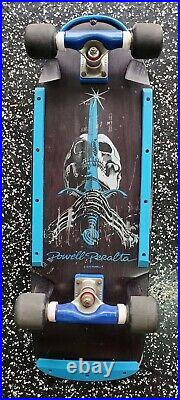
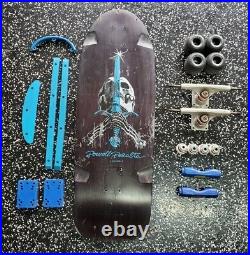
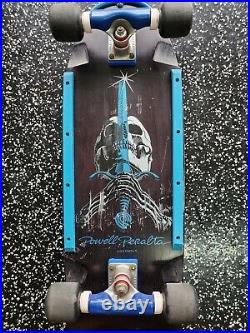
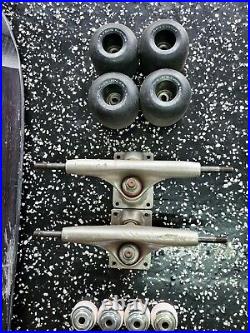
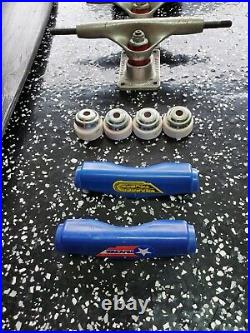
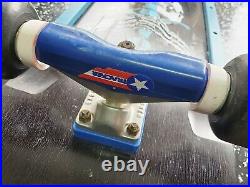
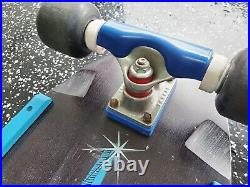
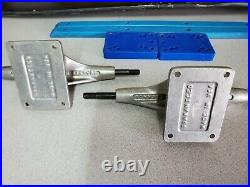
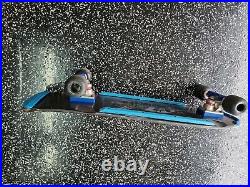
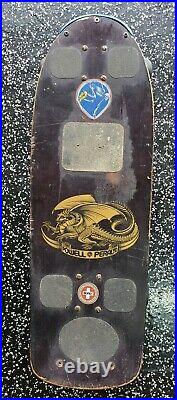
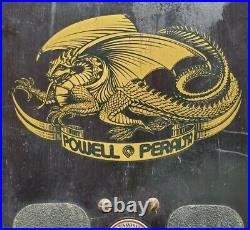
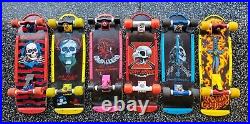
1983 Powell Peralta Skull And Sword Complete Vintage Skateboard Bones Brigade. Vintage Tracker Trucks with extremely light wear. Vintage Tracker Copers Blue light scratches on rear coper. Vintage Powell Peralta Gorilla Ribs very small scratches. Vintage NOS Powell Peralta tail bone. Vintage Powell Peralta Mini Cubic wheels. Original griptape and hardware. Tailbone and rails were held with tape for display. No holes drilled for rails. So more to come. Thank you for looking. Great piece for any vintage collector. The Real Story Behind Powell Peralta’s Skull and Sword Logo. George Powell, Stacy Peralta, and Ray “Bones” Rodriguez discuss the history of one of skating’s most iconic graphics. BY SEAN MORTIMER 7 JAN, 2015. In 1979, a skater, a matchbook, Rosie the Skeleton, and a former production foreman triggered a graphic revolution that continues to influence skate culture today. Ray “Bones” Rodriguez was the sole skater on Powell Peralta’s newly christened “Bones Brigade” who hadn’t been recruited by Stacy Peralta. George Powell-who started Powell skateboards in 1976-had picked Ray up before partnering with Stacy and re-launching under Powell Peralta in 1978. “Stacy had taken Ray on the team as a legacy skater because he was a great skater, ” George says. With Stacy purposely stepping away from his professional skate career, Powell Peralta needed a rider to represent the company. The pair agreed to reward Ray with his own signature model and followed Dogtown’s lead with colorful, illustrated graphics. But whereas Dogtown screened imaginative graffiti-based images based on its popular name-in-the-cross logo, Powell Peralta planned on incorporating visuals that spanned a broader graphical spectrum. Aesthetically, the company, like most of the industry, was a duller visual enterprise in 1979. Boards’ bottoms generally acted as brand billboards, and while George had developed Brite-Lite paints, which allowed the wood grain to show through near-neon colors, the simple font spelling the brand name offered little character. As Stacy and George brainstormed graphic concepts, Ray mentioned that he had an idea, but it was. Complicated. “I asked Ray for his ideas, but he kept saying it was too difficult to explain and that he’d send me a sketch, ” George says. “I went against the grain and did the opposite of a typical, clean surf knockoff logo, ” Ray says. I was 12 and wanted something powerful. We had a war memorabilia room [in our house], and I took the most head-lopping sword I could find and skeletal hands, mixed it with an original Grateful Dead skull [from the Steal Your Face album] and drew it on a matchbook cover. I had never really heard the band the Grateful Dead at the time, but I liked the skull. Expecting a preliminary drawing that he could work with, George was perplexed when he received a matchbook. “It was a scribble, ” George says. I rotated the matchbook, trying to decode what Ray had drawn, and failed, so I asked Stacy what Ray’s squiggles were supposed to be, and Stacy said,’Ray told me it was a skull with a sword in front of it. I looked at the scribble, and putting it in that context, I could sort of see it. As Powell Peralta integrated more graphic art into its marketing, George moved his brother-in-law, Vernon Courtlandt Johnson, out of production. “Court had always been an artist, ” George says. Until then, though, he had been unable to justify a full-time position. George deciphered the matchbook scribble for Court and stocked his new office. He needed something to draw from, so we bought our first skeleton and hung it in the art department and named it Rosie. Court proceeded to draw skulls with swords in front. The artist experimented with angles, contortions, and scale. “Court drew, and I suggested tweaks, until it had the right feeling and power and scariness without being ghoulish, ” George says. The idea was to capture a mix of fine art and swords and sorcery; the resulting illustration triggered an almost Jungian response from the teenage males who filled skateboarding’s ranks. “I like how the sword is transparent, giving it an ethereal, ghost-like quality, ” George says. And moving the perspective from full frontal to bottom-up, which puts it above you and gives it more strength and authority. Conservative parents were occasionally less enthused. When we first came out with the Ray Bones graphic, people were like,’That’s kind of sick, isn’t it? I remember even asking my parents,’What do you think about this? Is this going too far? Nonetheless, Powell Peralta continued in this direction. “Court had a style, and he eventually did most of the graphics, and so we developed a look, ” Stacy says. It was based around skeletons and fine-line drawings. In the’80s, skulls were a big look, and we just happened to jump on it at the right time. Back then, trends lasted longer-we rode that for at least six years. It seems laughable that a detailed, artistically drawn skull would provoke hysterical reaction, but for some in 1979, Powell Peralta had screened worse than pure shock value on a skateboard. Initially released in two distinctly different shapes; a 10″ x 30″ “Widetail” version and a 10″ x 28.5″ “Snub Nose, ” it came in “Brite-Lite” Dayglo yellow, orange, purple and green. In years to follow, it was made in various different colors and a Powell-Peralta logo was added. In 1983 Ray’s signature was removed and replaced with a Powell-Peralta script logo. “We didn’t think it was that dark, but it turned out other people thought it was dark, ” George says. It was an instant hit with skaters, but we received complaints from moms and dads, and had a fair amount of pushback from Southern religious groups threatening to boycott our product because they thought we were Satanically oriented. George and Stacy, however, were unfazed. “We followed the skull theme up with the Ripper, Mike McGill’s skull and snake, Tony Hawk’s bird skull, ” George says. We had a line of basically skull power symbols. Then they thought [Powell Peralta's] triple P logo-read upside down, in a mirror-stood for 666. Many people thought of us as Satanic. Now, more than a quarter century later, some of those iconic graphics appear on Christmas tree ornaments. The item “1983 Powell Peralta Skull And Sword Complete Vintage Skateboard Bones Brigade” is in sale since Sunday, May 16, 2021. This item is in the category “Sporting Goods\Outdoor Sports\Skateboarding & Longboarding\Vintage”. The seller is “vacationboots” and is located in Tustin, California. This item can be shipped to United States.
- Brand: Powell Peralta